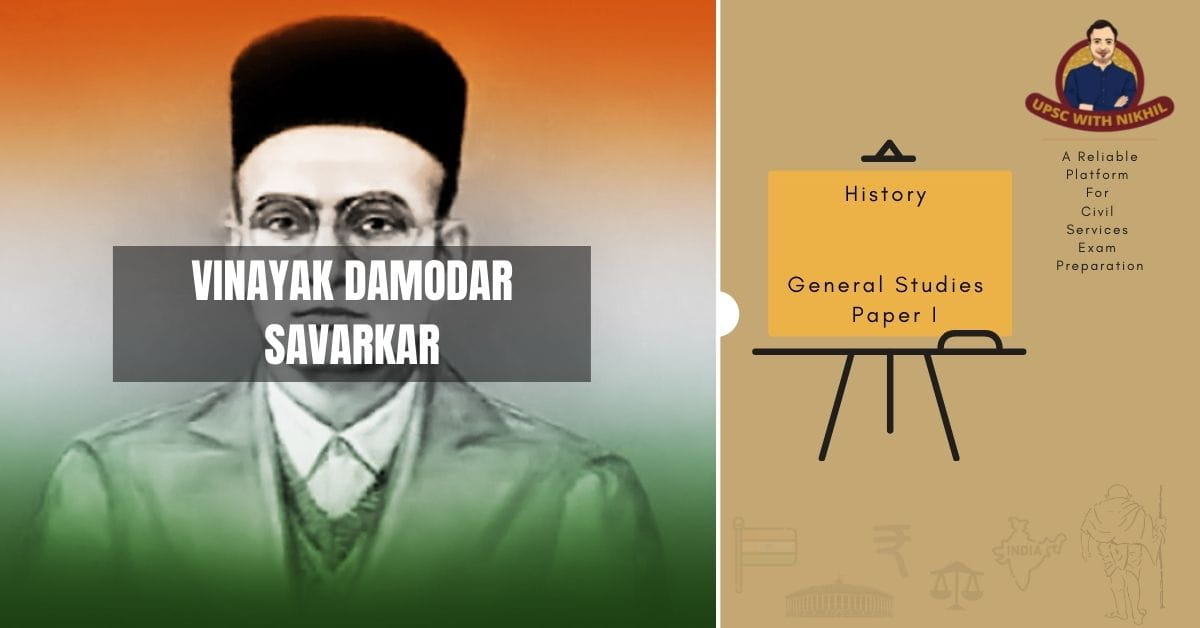Vinayak Damodar Savarkar
Vinayak Damodar was an activist for Indian independence, politician, lawyer, and journalist. Though he referred to his brand of 'Hindutva' as cultural rather than geographical India, many historians attribute a communal bent to this.
FACTS ABOUT HIS LIFE
• Vinayak Savarkar was born in Bhagur, Maharashtra, on the 28th of May 1883 to Damodar and Radhabai Savarkar.
• Fergusson College, Pune, was his place of study. Bal Gangadhar Tilak, Lala Lajpat Rai, and Bipin Chandra Pal were some of the leaders who influenced him. Protests against Bengal's partition and the Swadeshi movement also had an impact on him.
• He was a firm believer in patriotism and was drawn to radical ideologies and movements.
• Savarkar moved to England to study law after completing his degree. He lived in England at India House, a hotbed of nationalists and political activists.
• He founded the Free India Society to unite students in a revolution to gain India's independence.
• During this time, he wrote a book called "Indian War of Independence 1857," in which he described the 1857 Indian Revolt and criticised British rule as unjust and oppressive. He was among the first to refer to the uprising as India's "first war of independence." In India, this book was outlawed, but it was secretly published and distributed.
HIS CONTRIBUTIONS TO FREEDOM STRUGGLE
• Savarkar established the "Abhinav Bharat Society" in Pune.
• He was also a member of the Swadeshi movement before joining Tilak's Swaraj Party. The British government was enraged by his patriotic speeches and activities. As a result, his B.A. degree was revoked by the British government.
• Veer Savarkar left for London to study law in June 1906. Once in London, however, he rallied and inflamed Indian students in the United Kingdom against British rule in India. The Free India Society was founded by him.

• The Society commemorated important dates on the Indian calendar, such as festivals and landmarks in the Indian freedom movement, and was dedicated to promoting discussion about Indian independence.
• He believed in and advocated the use of arms to liberate India from the British, and he established a network of Indians in England who were armed.
• In 1908, he published an authentic and well-researched work on the Great Indian Revolt of 1857, which the British dubbed the "Sepoy Mutiny." The title of the book was "The Indian War of Independence 1857." The publication was immediately banned in both Britain and India by the British government. It was later published in Holland by Madame Bhikaiji Cama and smuggled into India to reach revolutionaries fighting British rule across the country.
• Veer Savarkar was finally apprehended by British authorities after the then British Collector of Nasik, A.M.T. Jackson, was shot by a youth. He was charged with the murder because of his ties to India House. On March 13, 1910, Savarkar was apprehended in London and deported to India.
• Many prominent freedom fighters demanded Savarkar's release in 1920, including Vithalbhai Patel, Mahatma Gandhi, and Bal Gangadhar Tilak. Savarkar was transferred to Ratnagiri jail on May 2, 1921, and then to the Yeravada jail. Savarkar wrote the book ‘Hindutva: Who is Hindu?' while imprisoned in Ratnagiri.
• From 1937 to 1943, Vinayak Savarkar served as the president of the Hindu Mahasabha. When the congress ministries resigned on October 22, 1939, the Hindu Mahasabha, led by him, collaborated with the Muslim League to form governments in provinces such as Sindh, Bengal, and the NWFP.
MODERNIST OUTLOOK
Savarkar openly embraced the "Era of Machines" and cautioned Indian leaders to learn from Europe's mistakes. His forward-thinking approach to Indian cinema was also admirable. He believed in the human mind's ability to innovate.
He was a multifaceted individual who wore many hats, including those of a freedom fighter, social reformer, writer, poet, historian, political leader, and philosopher. Biased historiography has resulted in the construction of a contentious narrative based on a rudimentary understanding of Savarkar.
Savarkar was a vocal opponent of the caste system, ensuring that children from the so-called lower castes were able to attend school. He gave their parents financial incentives and distributed slate and chalk to the children of these castes. “Once the children are educated together, they will not observe caste hierarchy later in life,” Savarkar said.
Savarkar would visit houses during Hindu festivals like Dussehra and Makar Sakranti, accompanied by people from various castes, and distribute traditional sweets. He raised a girl from an untouchable community and taught people from untouchable backgrounds how to read, write, and recite the Gayatri mantra.
Savarkar organised the first pan-Hindu Ganeshotsav in 1930. The celebrations would be marked by "kirtans" performed by the "untouchables." Many temple movements in Maharashtra were led by Savarkar, who encouraged untouchables to pray, recite Sanskrit hymns, and perform “Abhishek” of the Vishnu idol.
In Ratnagiri, the Patitpavan temple was established in 1931, with representation from all castes, including those from the erstwhile untouchable caste, on its trust. Savarkar opened a cafe for Hindus of all castes, including untouchables on May 1, 1933. This was India's very first pan-Hindu cafe. Savarkar also discussed how to end the caste system and untouchability.
KAALA PANI
• In his book "Indian War of Independence 1857," Savarkar discusses the guerilla warfare tactics used in the 1857 Sepoy Mutiny.
• While the book was banned in the United Kingdom, Madama Bhikaji Cama published it in the Netherlands, Germany, and France, reaching many Indian revolutionaries.
• In 1909, Savarkar was arrested for plotting an armed uprising against the MorleY-Minto reform. He also attempted to flee by diving into the water, but he was apprehended. In 1911, he was sentenced to two life sentences, i.e. 50 years in the Andamans cellular jail, also known as Kala Pani.
• Death – 1964: On February 1, 1966, Savarkar declared his desire to achieve Samadhi and began a hunger strike. He died on February 26, 1966. With India's independence, he believed his life's purpose had been fulfilled.


